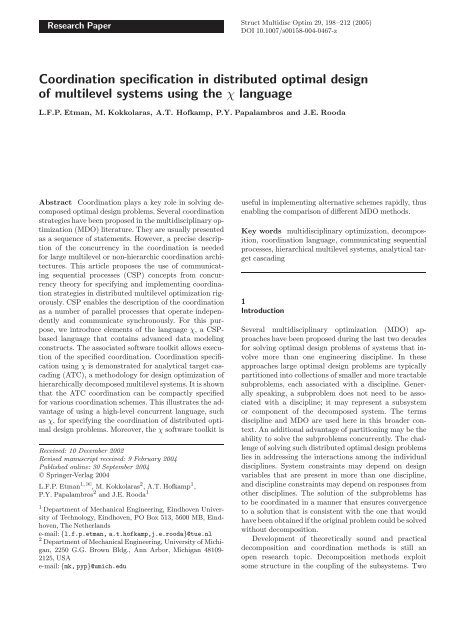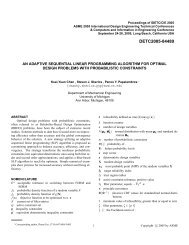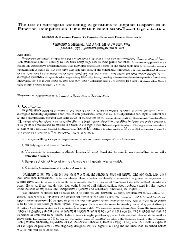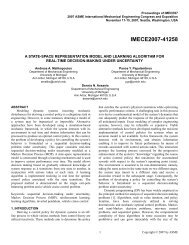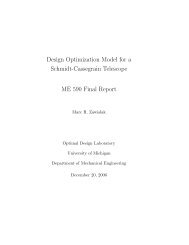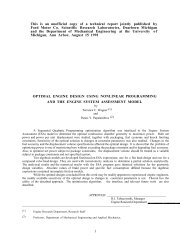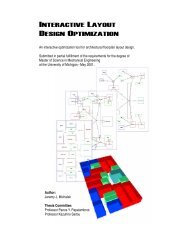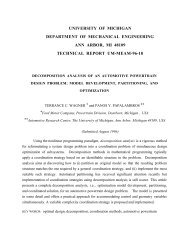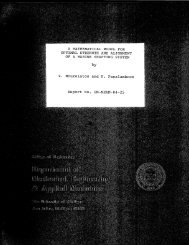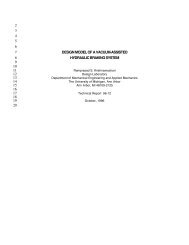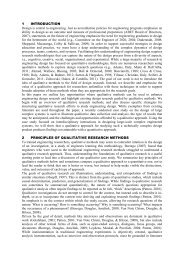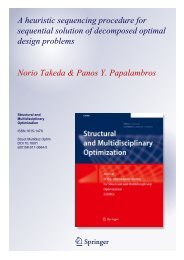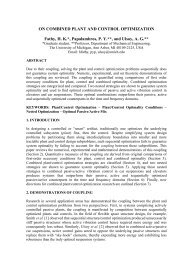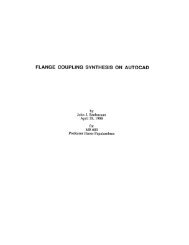Coordination specification in distributed optimal design of multilevel ...
Coordination specification in distributed optimal design of multilevel ...
Coordination specification in distributed optimal design of multilevel ...
Create successful ePaper yourself
Turn your PDF publications into a flip-book with our unique Google optimized e-Paper software.
Research Paper<br />
Struct Multidisc Optim 29, 198–212 (2005)<br />
DOI 10.1007/s00158-004-0467-z<br />
<strong>Coord<strong>in</strong>ation</strong> <strong>specification</strong> <strong>in</strong> <strong>distributed</strong> <strong>optimal</strong> <strong>design</strong><br />
<strong>of</strong> <strong>multilevel</strong> systems us<strong>in</strong>g the χ language<br />
L.F.P. Etman, M. Kokkolaras, A.T. H<strong>of</strong>kamp, P.Y. Papalambros and J.E. Rooda<br />
Abstract <strong>Coord<strong>in</strong>ation</strong> plays a key role <strong>in</strong> solv<strong>in</strong>g decomposed<br />
<strong>optimal</strong> <strong>design</strong> problems. Several coord<strong>in</strong>ation<br />
strategies have been proposed <strong>in</strong> the multidiscipl<strong>in</strong>ary optimization<br />
(MDO) literature. They are usually presented<br />
as a sequence <strong>of</strong> statements. However, a precise description<br />
<strong>of</strong> the concurrency <strong>in</strong> the coord<strong>in</strong>ation is needed<br />
for large <strong>multilevel</strong> or non-hierarchic coord<strong>in</strong>ation architectures.<br />
This article proposes the use <strong>of</strong> communicat<strong>in</strong>g<br />
sequential processes (CSP) concepts from concurrency<br />
theory for specify<strong>in</strong>g and implement<strong>in</strong>g coord<strong>in</strong>ation<br />
strategies <strong>in</strong> <strong>distributed</strong> <strong>multilevel</strong> optimization rigorously.<br />
CSP enables the description <strong>of</strong> the coord<strong>in</strong>ation<br />
as a number <strong>of</strong> parallel processes that operate <strong>in</strong>dependently<br />
and communicate synchronously. For this purpose,<br />
we <strong>in</strong>troduce elements <strong>of</strong> the language χ, aCSPbased<br />
language that conta<strong>in</strong>s advanced data model<strong>in</strong>g<br />
constructs. The associated s<strong>of</strong>tware toolkit allows execution<br />
<strong>of</strong> the specified coord<strong>in</strong>ation. <strong>Coord<strong>in</strong>ation</strong> <strong>specification</strong><br />
us<strong>in</strong>g χ is demonstrated for analytical target cascad<strong>in</strong>g<br />
(ATC), a methodology for <strong>design</strong> optimization <strong>of</strong><br />
hierarchically decomposed <strong>multilevel</strong> systems. It is shown<br />
that the ATC coord<strong>in</strong>ation can be compactly specified<br />
for various coord<strong>in</strong>ation schemes. This illustrates the advantage<br />
<strong>of</strong> us<strong>in</strong>g a high-level concurrent language, such<br />
as χ, for specify<strong>in</strong>g the coord<strong>in</strong>ation <strong>of</strong> <strong>distributed</strong> <strong>optimal</strong><br />
<strong>design</strong> problems. Moreover, the χ s<strong>of</strong>tware toolkit is<br />
Received: 10 December 2002<br />
Revised manuscript received: 9 February 2004<br />
Published onl<strong>in</strong>e: 30 September 2004<br />
© Spr<strong>in</strong>ger-Verlag 2004<br />
L.F.P. Etman 1, ✉ ,M.Kokkolaras 2 ,A.T.H<strong>of</strong>kamp 1 ,<br />
P.Y. Papalambros 2 and J.E. Rooda 1<br />
1 Department <strong>of</strong> Mechanical Eng<strong>in</strong>eer<strong>in</strong>g, E<strong>in</strong>dhoven University<br />
<strong>of</strong> Technology, E<strong>in</strong>dhoven, PO Box 513, 5600 MB, E<strong>in</strong>dhoven,<br />
The Netherlands<br />
e-mail: {l.f.p.etman, a.t.h<strong>of</strong>kamp,j.e.rooda}@tue.nl<br />
2 Department <strong>of</strong> Mechanical Eng<strong>in</strong>eer<strong>in</strong>g, University <strong>of</strong> Michigan,<br />
2250 G.G. Brown Bldg., Ann Arbor, Michigan 48109-<br />
2125, USA<br />
e-mail: {mk, pyp}@umich.edu<br />
useful <strong>in</strong> implement<strong>in</strong>g alternative schemes rapidly, thus<br />
enabl<strong>in</strong>g the comparison <strong>of</strong> different MDO methods.<br />
Key words multidiscipl<strong>in</strong>ary optimization, decomposition,<br />
coord<strong>in</strong>ation language, communicat<strong>in</strong>g sequential<br />
processes, hierarchical <strong>multilevel</strong> systems, analytical target<br />
cascad<strong>in</strong>g<br />
1<br />
Introduction<br />
Several multidiscipl<strong>in</strong>ary optimization (MDO) approaches<br />
have been proposed dur<strong>in</strong>g the last two decades<br />
for solv<strong>in</strong>g <strong>optimal</strong> <strong>design</strong> problems <strong>of</strong> systems that <strong>in</strong>volve<br />
more than one eng<strong>in</strong>eer<strong>in</strong>g discipl<strong>in</strong>e. In these<br />
approaches large <strong>optimal</strong> <strong>design</strong> problems are typically<br />
partitioned <strong>in</strong>to collections <strong>of</strong> smaller and more tractable<br />
subproblems, each associated with a discipl<strong>in</strong>e. Generally<br />
speak<strong>in</strong>g, a subproblem does not need to be associated<br />
with a discipl<strong>in</strong>e; it may represent a subsystem<br />
or component <strong>of</strong> the decomposed system. The terms<br />
discipl<strong>in</strong>e and MDO are used here <strong>in</strong> this broader context.<br />
An additional advantage <strong>of</strong> partition<strong>in</strong>g may be the<br />
ability to solve the subproblems concurrently. The challenge<br />
<strong>of</strong> solv<strong>in</strong>g such <strong>distributed</strong> <strong>optimal</strong> <strong>design</strong> problems<br />
lies <strong>in</strong> address<strong>in</strong>g the <strong>in</strong>teractions among the <strong>in</strong>dividual<br />
discipl<strong>in</strong>es. System constra<strong>in</strong>ts may depend on <strong>design</strong><br />
variables that are present <strong>in</strong> more than one discipl<strong>in</strong>e,<br />
and discipl<strong>in</strong>e constra<strong>in</strong>ts may depend on responses from<br />
other discipl<strong>in</strong>es. The solution <strong>of</strong> the subproblems has<br />
to be coord<strong>in</strong>ated <strong>in</strong> a manner that ensures convergence<br />
to a solution that is consistent with the one that would<br />
have been obta<strong>in</strong>ed if the orig<strong>in</strong>al problem could be solved<br />
without decomposition.<br />
Development <strong>of</strong> theoretically sound and practical<br />
decomposition and coord<strong>in</strong>ation methods is still an<br />
open research topic. Decomposition methods exploit<br />
some structure <strong>in</strong> the coupl<strong>in</strong>g <strong>of</strong> the subsystems. Two
199<br />
ma<strong>in</strong> types <strong>of</strong> decomposition methods can be identified:<br />
methods that orig<strong>in</strong>ate <strong>in</strong> rigorous mathematical<br />
formulations, and methods that emerged from MDO approaches<br />
<strong>in</strong> eng<strong>in</strong>eer<strong>in</strong>g; the latter tend to be heuristic.<br />
Mathematical decomposition methods generally use the<br />
structure <strong>of</strong> a large set <strong>of</strong> analytical constra<strong>in</strong>t equations<br />
to obta<strong>in</strong> a partition that can be coord<strong>in</strong>ated efficiently.<br />
Eng<strong>in</strong>eer<strong>in</strong>g-based methods are either aspect-driven or<br />
component-driven. They deal with “black-box” discipl<strong>in</strong>e<br />
analysis models that cannot be represented by analytical<br />
equations <strong>in</strong> the system optimization problem. Motivated<br />
by <strong>design</strong> practice, eng<strong>in</strong>eer<strong>in</strong>g-based methods aim at<br />
discipl<strong>in</strong>ary optimization autonomy by means <strong>of</strong> a <strong>multilevel</strong><br />
decomposition. Alexandrov and Lewis (2000, 2002)<br />
showed that some <strong>of</strong> those formulations exhibit convergence<br />
difficulties. Theoretically convergent <strong>multilevel</strong><br />
optimization methods are presented <strong>in</strong> Michelena et al.<br />
(2003) and Haftka and Watson (2004).<br />
Precise and compact <strong>specification</strong> <strong>of</strong> the coord<strong>in</strong>ation<br />
becomes <strong>in</strong>creas<strong>in</strong>gly important as the number <strong>of</strong> levels<br />
and subproblems grows. Implement<strong>in</strong>g coord<strong>in</strong>ation<br />
schemes for <strong>multilevel</strong> hierarchies or non-hierarchic problems<br />
becomes complicated and is prone to errors. Specify<strong>in</strong>g<br />
the sequence <strong>of</strong> solv<strong>in</strong>g the optimization subproblems<br />
and manag<strong>in</strong>g the necessary data exchange us<strong>in</strong>g<br />
programm<strong>in</strong>g languages such as Fortran or C is not a trivial<br />
task. Parallel process<strong>in</strong>g complicates matters even<br />
more. Hav<strong>in</strong>g the ability to implement the coord<strong>in</strong>ation<br />
at a higher level <strong>of</strong> abstraction is therefore advantageous.<br />
A coord<strong>in</strong>ation language with a clear concept <strong>of</strong> concurrency<br />
is necessary. It is preferable for such a concurrent<br />
<strong>specification</strong> language to have a highly expressive syntax<br />
with formal semantics.<br />
Available mathematical programm<strong>in</strong>g languages, e.g.,<br />
AMPL (Fourer et al. 1993), are typically geared towards<br />
formulat<strong>in</strong>g numerical optimization problems.<br />
In computer science, several languages have been developed<br />
to describe the coord<strong>in</strong>ation <strong>of</strong> concurrent processes.<br />
These coord<strong>in</strong>ation languages can be classified<br />
<strong>in</strong>to data-driven and control-driven (Papadopoulos and<br />
Arbab 1998). A data-driven language coord<strong>in</strong>ates data<br />
by means <strong>of</strong> a shared data space, while a controldriven<br />
(or process-oriented) language treats processes as<br />
“black-boxes” that are coord<strong>in</strong>ated through exchang<strong>in</strong>g<br />
state values or broadcast<strong>in</strong>g control messages. Aforementioned<br />
mathematical decomposition methods are<br />
suited to data-driven coord<strong>in</strong>ation, while “black-box”<br />
eng<strong>in</strong>eer<strong>in</strong>g-based methods fit the process-oriented coord<strong>in</strong>ation<br />
approach.<br />
Communicat<strong>in</strong>g sequential processes (CSP) is a popular<br />
theoretical foundation <strong>of</strong> process-oriented coord<strong>in</strong>ation<br />
languages (Hoare 1985; Roscoe 1997). CSP is particularly<br />
attractive for model<strong>in</strong>g coupled discipl<strong>in</strong>es and optimization<br />
subproblems <strong>in</strong> MDO, provided that suitable<br />
data language elements are available to deal with the numerical<br />
optimization sett<strong>in</strong>g. We propose to utilize CSP<br />
concepts for specify<strong>in</strong>g coord<strong>in</strong>ation <strong>in</strong> <strong>distributed</strong> <strong>optimal</strong><br />
<strong>design</strong> <strong>of</strong> <strong>multilevel</strong> systems. In particular, we adopt<br />
the CSP-based language χ (H<strong>of</strong>kamp and Rooda 2002a,b;<br />
Vervoort and Rooda 2003), which <strong>in</strong>cludes data types required<br />
for numerical optimization. The χ language was<br />
developed orig<strong>in</strong>ally for simulat<strong>in</strong>g discrete-event and<br />
hybrid (comb<strong>in</strong>ed discrete-event and cont<strong>in</strong>uous-time)<br />
manufactur<strong>in</strong>g systems (Van Beek et al. 2000). It is <strong>design</strong>ed<br />
primarily for model<strong>in</strong>g purposes; hence, it is easy<br />
to understand and has only few language constructs. The<br />
discrete-event part <strong>of</strong> χ is used <strong>in</strong> this work.<br />
The paper is organized as follows. First, MDO coord<strong>in</strong>ation<br />
architectures are reviewed and placed <strong>in</strong>to a CSP<br />
perspective. Then, several basic χ language elements necessary<br />
to specify the parallel processes and their <strong>in</strong>teractions<br />
are <strong>in</strong>troduced. This paper focuses on hierarchically<br />
decomposed <strong>multilevel</strong> systems. In this regard, coord<strong>in</strong>ation<br />
<strong>specification</strong> by means <strong>of</strong> the χ language is<br />
demonstrated for analytical target cascad<strong>in</strong>g (ATC). An<br />
overview <strong>of</strong> the ATC formulation is given and different<br />
coord<strong>in</strong>ation strategies are discussed. A simple yet illustrative<br />
example with a three-level hierarchy is used to<br />
show the advantage <strong>of</strong> the approach and demonstrate<br />
that different ATC coord<strong>in</strong>ation strategies can be specified<br />
efficiently. F<strong>in</strong>ally, the ma<strong>in</strong> f<strong>in</strong>d<strong>in</strong>gs are summarized<br />
and discussed.<br />
2<br />
Multidiscipl<strong>in</strong>ary optimization<br />
In this section we review the general MDO problem formulation,<br />
summarize ma<strong>in</strong> solution strategies, and consider<br />
a new concept for MDO coord<strong>in</strong>ation.<br />
2.1<br />
Problem formulation<br />
The general MDO problem can be stated as follows: F<strong>in</strong>d<br />
the values <strong>of</strong> the discipl<strong>in</strong>e <strong>design</strong> variables such that<br />
a system objective is optimized subject to system and discipl<strong>in</strong>ary<br />
<strong>design</strong> constra<strong>in</strong>ts, <strong>in</strong>terdiscipl<strong>in</strong>ary <strong>design</strong> variable<br />
coupl<strong>in</strong>g constra<strong>in</strong>ts, and <strong>in</strong>terdiscipl<strong>in</strong>ary response<br />
variable coupl<strong>in</strong>g constra<strong>in</strong>ts.<br />
A set <strong>of</strong> <strong>design</strong> variables x i is identified for each discipl<strong>in</strong>e<br />
i =1, 2,... ,m,wherem is the number <strong>of</strong> discipl<strong>in</strong>es.<br />
Some <strong>of</strong> the <strong>design</strong> variables may be shared <strong>in</strong><br />
several discipl<strong>in</strong>es: this shar<strong>in</strong>g is represented by <strong>in</strong>terdiscipl<strong>in</strong>ary<br />
<strong>design</strong> variable coupl<strong>in</strong>g equations<br />
k(x 1 , x 2 ,... ,x m )=0. Discipl<strong>in</strong>e constra<strong>in</strong>ts g i ≤ 0 depend<br />
only on discipl<strong>in</strong>e <strong>design</strong> variables x i and discipl<strong>in</strong>e<br />
responses r i . System constra<strong>in</strong>ts g 0 ≤ 0 may depend on<br />
all <strong>design</strong> variables and responses. The same holds for the<br />
system objective f.<br />
Interdiscipl<strong>in</strong>ary response variables coupl<strong>in</strong>g is represented<br />
by equations l(c 1 , c 2 ,... ,c m , r 1 , r 2 ,... ,r m )=0.<br />
These equations relate responses r j <strong>of</strong> discipl<strong>in</strong>e j that are<br />
<strong>in</strong>puts c i to discipl<strong>in</strong>e i, j ≠ i. F<strong>in</strong>ally, discipl<strong>in</strong>e responses<br />
are functions <strong>of</strong> discipl<strong>in</strong>e <strong>design</strong> variables and, possibly,
200<br />
responses <strong>of</strong> other discipl<strong>in</strong>es, and are computed us<strong>in</strong>g analysis<br />
or simulation models: r i = a i (x i , c i ).<br />
Based on the above def<strong>in</strong>itions, the MDO problem can<br />
be formulated mathematically as<br />
m<strong>in</strong> f(x 1 , x 2 ,... ,x m , r 1 , r 2 ,... ,r m )<br />
w.r.t.<br />
x 1 , x 2 ,... ,x m , r 1 , r 2 ,... ,r m , c 1 , c 2 ,... ,c m<br />
s.t. g 0 (x 1 , x 2 ,... ,x m , r 1 , r 2 ,... ,r m ) ≤ 0<br />
Fig. 1 Individual discipl<strong>in</strong>e feasible architecture<br />
g i (x i , r i ) ≤ 0 , i=1, 2,... ,m<br />
k(x 1 , x 2 ,... ,x m )=0<br />
l(c 1 , c 2 ,... ,c m , r 1 , r 2 ,... ,r m )=0<br />
r i − a i (x i , c i )=0 , i=1, 2,... ,m<br />
x i ∈X i , i=1, 2,... ,m. (1)<br />
2.2<br />
Classification <strong>of</strong> MDO architectures<br />
Several methods for MDO can be found <strong>in</strong> the literature.<br />
Classifications <strong>of</strong> the associated architectures are presented<br />
<strong>in</strong> Cramer et al. (1994), Ball<strong>in</strong>g and Sobieszczanski-Sobieski<br />
(1996), and Alexandrov and Lewis (1999).<br />
The key element <strong>in</strong> these classifications is the way feasibility<br />
<strong>of</strong> the constra<strong>in</strong>ts <strong>in</strong> Problem (1) is ma<strong>in</strong>ta<strong>in</strong>ed.<br />
Cramer et al. (1994) classify MDO methods <strong>in</strong>to “allat-once”<br />
(AAO), <strong>in</strong>dividual discipl<strong>in</strong>e feasible (IDF), and<br />
multidiscipl<strong>in</strong>ary feasible (MDF). The formulation <strong>of</strong><br />
Problem (1) corresponds to the IDF strategy. The analysis<br />
equations appear nested (Ball<strong>in</strong>g and Sobieszczanski-Sobieski<br />
1996) or closed (Alexandrov and Lewis<br />
1999) with respect to the system optimization problem<br />
(cf. Fig. 1). S<strong>in</strong>ce response coupl<strong>in</strong>g is <strong>in</strong>cluded <strong>in</strong> the system<br />
optimization, the system will be <strong>in</strong>terdiscipl<strong>in</strong>arily<br />
feasible (i.e., satisfy the response coupl<strong>in</strong>g constra<strong>in</strong>ts)<br />
only after convergence has been achieved.<br />
To guarantee <strong>in</strong>terdiscipl<strong>in</strong>ary feasibility at each iteration<br />
<strong>of</strong> the optimization, one has to treat response<br />
coupl<strong>in</strong>g as nested with respect to the system optimization,<br />
as shown <strong>in</strong> Fig. 2. Evaluat<strong>in</strong>g a system <strong>design</strong> x =<br />
[x t 1 , xt 2 ,... ,xt m ]t to obta<strong>in</strong> responses r =[r t 1 , rt 2 ,... ,rt m ]t<br />
automatically implies that coupled discipl<strong>in</strong>ary responses<br />
are consistent. Cramer et al. (1994) refer to this strategy<br />
as MDF.<br />
Ball<strong>in</strong>g and Sobieszczanski-Sobieski (1996) dist<strong>in</strong>guish<br />
between s<strong>in</strong>gle-level and <strong>multilevel</strong> architectures.<br />
S<strong>in</strong>gle-level refers to an architecture where only the system<br />
optimization problem determ<strong>in</strong>es the <strong>design</strong> variable<br />
values. In the <strong>multilevel</strong> case discipl<strong>in</strong>ary optimizers are<br />
<strong>in</strong>troduced to determ<strong>in</strong>e the <strong>in</strong>dependent discipl<strong>in</strong>e <strong>design</strong><br />
variables, while the system optimizer determ<strong>in</strong>es<br />
the shared <strong>design</strong> variables. From the system optimizer’s<br />
po<strong>in</strong>t <strong>of</strong> view the discipl<strong>in</strong>ary constra<strong>in</strong>ts g i ≤ 0 will always<br />
be satisfied (i.e., they are closed <strong>design</strong> constra<strong>in</strong>ts<br />
Fig. 2 Multidiscipl<strong>in</strong>ary feasible architecture<br />
Fig. 3 Hierarchical <strong>multilevel</strong> architecture<br />
accord<strong>in</strong>g to the classification <strong>in</strong> Alexandrov and Lewis<br />
(1999)). An example <strong>of</strong> a hierarchical <strong>multilevel</strong> architecture<br />
is shown <strong>in</strong> Fig. 3, where x + i and r + i represent targets<br />
for <strong>design</strong> variables and responses provided by the system<br />
optimizer, respectively, while x ∗ i and r∗ i represent the<br />
values that are returned from the discipl<strong>in</strong>e optimizers.<br />
Appropriate coord<strong>in</strong>ation strategies must be specified<br />
for solv<strong>in</strong>g the subproblems. <strong>Coord<strong>in</strong>ation</strong> algorithms <strong>in</strong><br />
the MDO literature are usually presented as step-wise<br />
sequential procedures, sometimes visualized by flow diagrams.<br />
However, a sequential description <strong>of</strong> the coord<strong>in</strong>ation<br />
<strong>in</strong> a <strong>distributed</strong> MDO architecture requires the<br />
description <strong>of</strong> the exact order <strong>of</strong> communications (data<br />
exchange) for all subsystems. For <strong>multilevel</strong> and nonhierarchic<br />
decompositions this is a tedious task that is<br />
prone to errors, especially when the problem size grows<br />
(many levels and/or subproblems). To avoid this, one
201<br />
should be able to specify the (concurrency <strong>in</strong> the) coord<strong>in</strong>ation<br />
at a higher level <strong>of</strong> abstraction, i.e., by means <strong>of</strong><br />
an appropriate concurrent language based on computer<br />
science.<br />
2.3<br />
Communicat<strong>in</strong>g sequential processes and MDO<br />
coord<strong>in</strong>ation<br />
Several theoretical foundations are available to describe<br />
systems that exhibit concurrent behavior. A short overview<br />
is given <strong>in</strong> the <strong>in</strong>troduction <strong>of</strong> Bos and Kleijn<br />
(2002). Communicat<strong>in</strong>g sequential processes (CSP) concepts<br />
(Hoare 1978, 1985; Roscoe 1997) are highly suited<br />
for specify<strong>in</strong>g coord<strong>in</strong>ation <strong>in</strong> MDO. They model coord<strong>in</strong>ation<br />
as parallel processes that operate <strong>in</strong>dependently<br />
and communicate synchronously over predef<strong>in</strong>ed channels.<br />
The CSP concept matches eng<strong>in</strong>eer<strong>in</strong>g-based MDO<br />
methods that partition <strong>optimal</strong> system <strong>design</strong> problems<br />
<strong>in</strong>to a collection <strong>of</strong> smaller subproblems. Each subproblem<br />
can be seen as an <strong>in</strong>dependent “black-box” process,<br />
while the necessary data exchange among subproblems<br />
can be viewed as a series <strong>of</strong> communications.<br />
The MDO problem formulations shown <strong>in</strong> Figs. 1, 2,<br />
and3canbecoord<strong>in</strong>atedus<strong>in</strong>g CSP concepts. Each circle<br />
represents a process that is responsible for the closure <strong>of</strong><br />
a specific set <strong>of</strong> constra<strong>in</strong>ts. Processes can be executed <strong>in</strong><br />
parallel assum<strong>in</strong>g that they are not wait<strong>in</strong>g for data from<br />
other processes. Such <strong>in</strong>put/output relations among processes<br />
are modeled as communication channels, visualized<br />
by arrows that illustrate the direction <strong>of</strong> <strong>in</strong>formation flow.<br />
Us<strong>in</strong>g CSP, communication sequences are def<strong>in</strong>ed locally<br />
for each process. Any order <strong>of</strong> communication among processes<br />
is allowed as long as the local process communication<br />
sequences are obeyed.<br />
In our op<strong>in</strong>ion, MDO coord<strong>in</strong>ation benefits greatly<br />
by us<strong>in</strong>g a <strong>specification</strong> language based on elements <strong>of</strong><br />
concurrent programm<strong>in</strong>g, especially for <strong>multilevel</strong> hierarchies<br />
and non-hierarchic schemes. Such a language enables<br />
a formal and precise description <strong>of</strong> the MDO processes<br />
(typically related to analysis or optimization) and<br />
the communication among them. We demonstrate this<br />
us<strong>in</strong>g the CSP-based χ language developed by the Systems<br />
Eng<strong>in</strong>eer<strong>in</strong>g group at the E<strong>in</strong>dhoven University <strong>of</strong><br />
Technology <strong>in</strong> the Netherlands.<br />
3<br />
<strong>Coord<strong>in</strong>ation</strong> <strong>specification</strong> us<strong>in</strong>g the χ language<br />
The χ <strong>specification</strong> language has been developed orig<strong>in</strong>ally<br />
for model<strong>in</strong>g manufactur<strong>in</strong>g systems that exhibit<br />
complex concurrent behavior. It is a language <strong>design</strong>ed<br />
primarily for model<strong>in</strong>g pure discrete-event concurrent<br />
systems or systems that comb<strong>in</strong>e discrete-event and cont<strong>in</strong>uous<br />
time behavior (Van Beek et al. 2000). We will<br />
show that the discrete-event part <strong>of</strong> χ is well suited for<br />
specify<strong>in</strong>g coord<strong>in</strong>ation <strong>of</strong> <strong>distributed</strong> <strong>optimal</strong> system <strong>design</strong><br />
problems <strong>in</strong> a formal and rigorous manner. A brief<br />
<strong>in</strong>formal description <strong>of</strong> the χ syntax (denotation <strong>of</strong> language<br />
elements) and semantics (mean<strong>in</strong>g <strong>of</strong> language<br />
elements) is presented <strong>in</strong> this section. A complete formal<br />
def<strong>in</strong>ition <strong>of</strong> the language can be found <strong>in</strong> Bos and Kleijn<br />
(2002). A tutorial <strong>in</strong>troduction is given by Vervoort and<br />
Rooda (2003).<br />
The χ language is highly expressive with only a small<br />
number <strong>of</strong> orthogonal language elements. It is easy to<br />
understand and comb<strong>in</strong>es a well-def<strong>in</strong>ed concept <strong>of</strong> concurrency<br />
with advanced data model<strong>in</strong>g constructs. The<br />
discrete-event part <strong>of</strong> χ is based on CSP (Hoare 1978) and<br />
Dijkstra’s guarded command language (Dijkstra 1975).<br />
Parallel behavior is restricted to occur among processes<br />
(follow<strong>in</strong>g Van de Mortel-Fronczak et al. (1995)). Individual<br />
processes are specified <strong>in</strong> an imperative way us<strong>in</strong>g<br />
a sequence <strong>of</strong> statements. For readability <strong>of</strong> the <strong>specification</strong>,<br />
systems can be <strong>in</strong>troduced to represent collections <strong>of</strong><br />
coupled processes, as well as functions to def<strong>in</strong>e calculations.<br />
Interactions among processes are modeled as synchronous<br />
communications over channels (Hoare 1985).<br />
Synchronous means that communication between two<br />
processes takes place only when both are will<strong>in</strong>g to communicate,<br />
and that such a communication takes place <strong>in</strong>stantly<br />
(no storage <strong>in</strong> the channel). The concepts <strong>of</strong> time<br />
and probability, which play a key role <strong>in</strong> model<strong>in</strong>g manufactur<strong>in</strong>g<br />
systems, are also available <strong>in</strong> χ. Inthiswork,<br />
these concepts do not play a role <strong>in</strong> MDO coord<strong>in</strong>ation,<br />
and are therefore omitted.<br />
The ma<strong>in</strong> def<strong>in</strong>itions for communicat<strong>in</strong>g sequential<br />
processes us<strong>in</strong>g χ can be summarized as follows:<br />
–Aprocess represents a sequentially behav<strong>in</strong>g component<br />
<strong>in</strong> a larger concurrent system.<br />
–Asystem is a collection <strong>of</strong> concurrent processes that<br />
cooperate by synchronous <strong>in</strong>teraction. A system behaves<br />
like a process and can aga<strong>in</strong> be part <strong>of</strong> other<br />
systems.<br />
–Achannel represents a connection between two processes,<br />
and enables <strong>in</strong>teraction between them.<br />
– Interaction (communication) between two processes<br />
means <strong>in</strong>stantaneous data exchange (through a po<strong>in</strong>tto-po<strong>in</strong>t<br />
channel).<br />
3.1<br />
Data types<br />
MDO coord<strong>in</strong>ation formulations usually generate considerable<br />
amounts <strong>of</strong> (numerical) data that have to be<br />
exchanged among the subproblems. Therefore, a coord<strong>in</strong>ation<br />
language for MDO has to provide language constructs<br />
to model this data flow compactly. The χ language<br />
satisfies this requirement. χ has several built-<strong>in</strong> data<br />
types, and dist<strong>in</strong>guishes basic data types and conta<strong>in</strong>er<br />
data types. The basic data types are: bool (boolean), nat<br />
(natural), <strong>in</strong>t (<strong>in</strong>teger), real, str<strong>in</strong>g, and void. The void<br />
type is the empty data type used <strong>in</strong> the declaration <strong>of</strong>
202<br />
synchronization channels and ports. Conta<strong>in</strong>er data types<br />
are: array, tuple, and list, among others. These three conta<strong>in</strong>er<br />
data types are briefly expla<strong>in</strong>ed below, where T<br />
denotes a data type that is either basic or conta<strong>in</strong>er.<br />
T n is an array <strong>of</strong> fixed length n conta<strong>in</strong><strong>in</strong>g data elements<br />
<strong>of</strong> type T .Asanexample,〈2.1, 4.8, −4.9〉 is an array<br />
<strong>of</strong> type real 3 . Arrays can be built from any basic or<br />
conta<strong>in</strong>er data type provided that the elements are <strong>of</strong><br />
identical type. This means that an m × n matrix <strong>of</strong><br />
reals can be represented by (real n ) m . The <strong>in</strong>dex operator<br />
.i (0 ≤ i ≤ n − 1) allows to access the elements <strong>in</strong><br />
the array, e.g., 〈2.1, 4.8, −4.9〉.1 returns 4.8.<br />
T 0 × T 1 × T 2 × ...× T m denotes a tuple that is a more<br />
general form <strong>of</strong> an array <strong>in</strong> the sense that the elements<br />
<strong>of</strong> a tuple need not be <strong>of</strong> the same type. A tuple<br />
is comparable to a record <strong>in</strong> Pascal. For example, we<br />
may have two-tuple conta<strong>in</strong><strong>in</strong>g arrays, like bool 2 ×<br />
real 3 . Similar to the array, elements <strong>of</strong> a tuple may<br />
be either basic or conta<strong>in</strong>er data types and can be accessed<br />
by the <strong>in</strong>dex operator.<br />
T ∗ is a list conta<strong>in</strong><strong>in</strong>g an ordered sequence <strong>of</strong> elements<br />
that must all be <strong>of</strong> the same type T .Anexample<strong>of</strong><br />
a list <strong>of</strong> type nat ∗ is [1, 2, 3]. The length <strong>of</strong> the list is<br />
variable, that is, elements can be added to or removed<br />
from the list. The empty list is [ ]. In addition to the<br />
concatenation (addition) and subtraction (removal)<br />
operators, a number <strong>of</strong> functions are available, e.g.,<br />
for access<strong>in</strong>g the value <strong>of</strong> the first element <strong>of</strong> a list or<br />
query<strong>in</strong>g the length <strong>of</strong> a list.<br />
Discipl<strong>in</strong>es responses and optimization results are typically<br />
generated <strong>in</strong> the form <strong>of</strong> arrays or tuples <strong>of</strong> arrays.<br />
Lists are suitable for stor<strong>in</strong>g data that are needed <strong>in</strong> later<br />
iterations.<br />
3.2<br />
Processes<br />
The basic build<strong>in</strong>g block <strong>of</strong> a χ model is a process. The<br />
process def<strong>in</strong>ition has the follow<strong>in</strong>g general format:<br />
proc N(V p )=|[V l |S p ]| .<br />
The process is identified by its name N and parameters<br />
V p ; the latter are represented by a comma-separated list<br />
<strong>of</strong> (formal) parameters <strong>of</strong> the form v : type,wheretype can<br />
be a standard data type T ,asendport(v : !T )datatype,<br />
or a receive port (v : ?T ) data type. It is also allowed to<br />
have arrays <strong>of</strong> ports (v :(!T ) n ,andv :(?T ) n ). The body<br />
<strong>of</strong> the process is specified between the brackets |[ and]|.<br />
Local variables V l are declared first, followed by the sequence<br />
<strong>of</strong> statements S p to be executed by the process.<br />
Table 1 presents, us<strong>in</strong>g BNF format (Backus 1960),<br />
the syntax <strong>of</strong> a subset <strong>of</strong> χ process statements that is<br />
relevant for specify<strong>in</strong>g an MDO coord<strong>in</strong>ation. The statements<br />
are expla<strong>in</strong>ed below <strong>in</strong>formally.<br />
Table 1 Syntax <strong>of</strong> χ process statements<br />
S p ::= skip (skip)<br />
| x := e (assignment)<br />
| E (event)<br />
| S p ; S p (sequential composition)<br />
| [GC ] (guarded command)<br />
|∗[GC ] (repetitive guarded command)<br />
| [SW ] (selective wait<strong>in</strong>g)<br />
|∗[SW ] (repetitive selective wait<strong>in</strong>g)<br />
E ::= p ! e (send)<br />
| p ? x (receive)<br />
| p ! (synchronization send)<br />
| p ? (synchronization receive)<br />
GC ::= e b −→ S p<br />
| R : e b −→ S p<br />
| GC [] GC<br />
SW ::= e b ; E −→ S p<br />
| R: e b ; E −→ S p<br />
| SW [] SW<br />
R ::= i: nat← l..u (range <strong>in</strong>clud<strong>in</strong>g l, exclud<strong>in</strong>g u)<br />
| R, R (range list).<br />
skip means do noth<strong>in</strong>g. It is used <strong>in</strong> selection statements<br />
to express that noth<strong>in</strong>g needs to be done when a certa<strong>in</strong><br />
guard evaluates to true.<br />
x := e denotes the assignment statement. The value that<br />
follows from the evaluation <strong>of</strong> expression e is assigned<br />
to variable x.Thetypes<strong>of</strong>x and e have to be the same.<br />
Multi-assignment is also allowed, e.g., 〈x, y〉 := 〈e 1 ,e 2 〉<br />
S p1 ; S p2 denote that statement S p2 is executed after the<br />
execution <strong>of</strong> statement S p1 has been completed, that<br />
is, process statements are executed sequentially. In the<br />
sequel, a statement denoted by S p may also be the<br />
concatenation <strong>of</strong> multiple process statements.<br />
E represents an event statement. This <strong>in</strong>cludes the send<br />
statement (p ! e), the receive statement (p ? x), the<br />
synchronization send statement (p !), and the synchronization<br />
receive statement (p ?). The send statement<br />
p ! e tries to send the evaluation outcome <strong>of</strong> expression<br />
e over the channel connected to port p. Thissend<br />
statement succeeds if the other process connected to<br />
the same channel is will<strong>in</strong>g to receive. Similarly, the receive<br />
statement p ? x waits until data through port p is<br />
received and assigns this data to variable x.Theports,<br />
variables, and expressions must have equal types. Synchronization<br />
is a communication statement without<br />
transferr<strong>in</strong>g data. It is used to exchange an acknowledgment.<br />
A synchronization statement succeeds when<br />
the process connected to the same channel is also will<strong>in</strong>g<br />
to synchronize.<br />
[GC ] stands for guarded command statement or selection<br />
statement. This statement <strong>of</strong>fers a choice between<br />
several guarded alternatives. Each alternative is specified<br />
us<strong>in</strong>g the syntax e b −→ S p ,wheree b is the boolean<br />
expression denot<strong>in</strong>g the guard. The different alterna-
203<br />
tives are separated by the symbol []. Upon execution <strong>of</strong><br />
the selection statement the guards <strong>of</strong> all alternatives<br />
are evaluated. If one <strong>of</strong> the guards evaluates to true,<br />
the correspond<strong>in</strong>g process statement S p is executed. If<br />
more than one guard happens to be true then one <strong>of</strong><br />
the true alternatives is chosen non-determ<strong>in</strong>istically,<br />
i.e., noth<strong>in</strong>g can be said about which choice will be<br />
made. If no guard evaluates to true an error occurs.<br />
∗[GC ] is the repetitive guarded command or repetitive<br />
selection statement that allows one to carry out the<br />
selection statement GC repeatedly. The repetition is<br />
cont<strong>in</strong>ued until all guards evaluate to false. When this<br />
happens, the repetition ends and the statement follow<strong>in</strong>g<br />
the repetitive guarded command is executed.<br />
[SW ] denotes selective wait<strong>in</strong>g. The selective wait<strong>in</strong>g<br />
statement is an extended version <strong>of</strong> the selection statement<br />
where the guard <strong>of</strong> an alternative is replaced<br />
by the pair <strong>of</strong> a guard (boolean expression) and an<br />
event statement: e b ; E −→ S p . When the selective<br />
wait<strong>in</strong>g statement is executed, all guards are evaluated<br />
once. For the guards that have evaluated to true,<br />
the construct waits until at least one <strong>of</strong> the event<br />
statements can be carried out. If the event statement<br />
<strong>of</strong> just one alternative is possible, this statement is<br />
executed followed by the correspond<strong>in</strong>g process statements.<br />
If event statements <strong>of</strong> multiple alternatives<br />
happen to be possible, one event statement is chosen<br />
non-determ<strong>in</strong>istically followed by the execution <strong>of</strong> the<br />
process statements <strong>of</strong> the correspond<strong>in</strong>g alternative. If<br />
none <strong>of</strong> the guards evaluates to true an error occurs.<br />
∗[SW ] represents repetitive selective wait<strong>in</strong>g and repeats<br />
the selective wait<strong>in</strong>g statement until all guards evaluate<br />
to false. After the end <strong>of</strong> the repetition, the statement<br />
follow<strong>in</strong>g the repetitive selective wait<strong>in</strong>g statement<br />
is executed.<br />
A range expression R canbeused<strong>in</strong>theguardedcommand<br />
and selective wait<strong>in</strong>g statement to enable compact<br />
notation. The range expression allows the def<strong>in</strong>ition <strong>of</strong><br />
variables that are varied with<strong>in</strong> certa<strong>in</strong> lower and upper<br />
bounds.<br />
The key statements to specify communication among<br />
concurrent processes are the send, receive, and synchronize<br />
statements, as well as the (repetitive) selective wait<strong>in</strong>g<br />
statement. The latter is the most powerful statement<br />
<strong>of</strong> χ for the <strong>specification</strong> <strong>of</strong> the communication between<br />
concurrent processes. The communication <strong>of</strong> a process<br />
with other processes can be specified without the need to<br />
predef<strong>in</strong>e some sequence <strong>of</strong> communication. Such a selective<br />
wait<strong>in</strong>g construct is essential for the <strong>specification</strong> <strong>of</strong><br />
complex coord<strong>in</strong>ation schemes.<br />
3.3<br />
Systems<br />
Processes can be grouped together <strong>in</strong> a system by parallel<br />
composition. The processes <strong>in</strong> the system are coupled<br />
through channels. Such a system acts like a process and<br />
can be comb<strong>in</strong>ed with other processes to form a new system.<br />
A χ system is def<strong>in</strong>ed as follows:<br />
syst N(V s )=|[V c |S s ]|<br />
A system is identified by its name N and parameters V s .<br />
System parameters V s have the same format as process<br />
parameters V p expla<strong>in</strong>ed <strong>in</strong> the previous section. The system<br />
body resides between |[ and]| brackets, and starts<br />
with a declaration list <strong>of</strong> local channel variables V c ,followed<br />
by system statement S s . A channel variable c <strong>of</strong><br />
type T is declared us<strong>in</strong>g the syntax c: − T . Only values <strong>of</strong><br />
type T can be communicated through this channel.<br />
The processes and systems are <strong>in</strong>stantiated <strong>in</strong> the system<br />
statements S s with the appropriate channels and parameters.<br />
Instantiations are written as N(e 1 ,e 2 , ..., e n ),<br />
where N is the name <strong>of</strong> an exist<strong>in</strong>g process or system and<br />
e i (1 ≤ i ≤ n) is an expression result<strong>in</strong>g <strong>in</strong> a value <strong>of</strong> the<br />
appropriate data type. Processes and systems are <strong>in</strong>stantiated<br />
<strong>in</strong> parallel us<strong>in</strong>g the parallel composition operator<br />
S s ‖ S s . The local channel variables are used to connect<br />
different process <strong>in</strong>stantiations to each other. A s<strong>in</strong>gle<br />
channel connects one send port to one receive port. The<br />
data types <strong>of</strong> the two connected ports and the channel<br />
must match. Bundles (arrays) <strong>of</strong> channels can be specified<br />
as well.<br />
A closed system has to be <strong>in</strong>stantiated at the top level.<br />
This closed system has no communication ports parameters.<br />
The environment<br />
xper = |[N(e 1 ,e 2 ,... ,e n )]|<br />
<strong>in</strong>stantiates top level system N with parameter values e 1<br />
to e n ,wheree i can be a basic or conta<strong>in</strong>er data type, but<br />
not a port or channel data type.<br />
3.4<br />
Functions<br />
Functions can be used to def<strong>in</strong>e calculations that cannot<br />
be expressed <strong>in</strong> a s<strong>in</strong>gle l<strong>in</strong>e or that appear at several different<br />
places <strong>in</strong> the <strong>specification</strong>. The calculation is performed<br />
each time the function is called by a process. A χ<br />
function is def<strong>in</strong>ed as<br />
func N(V f ) → T r = |[V l |S f ]|<br />
and identified by its name N and a list <strong>of</strong> formal <strong>in</strong>put parameters<br />
V f <strong>of</strong> type v : T . The return type <strong>of</strong> the function<br />
is T r .BothT and T r are basic or conta<strong>in</strong>er data types.<br />
Local variables x: T may be <strong>in</strong>troduced <strong>in</strong> V l , followed by<br />
the sequence <strong>of</strong> statements S f that def<strong>in</strong>es the function.<br />
The statements that may be used <strong>in</strong> a function<br />
are the guarded command statement, the repetitive<br />
guarded command statement, sequential composition,<br />
assignment, and the skip statement as def<strong>in</strong>ed earlier<br />
<strong>in</strong> Sect. 3.2. One new statement is the return statement
204<br />
↑ e that completes the execution <strong>of</strong> the function and returns<br />
the value <strong>of</strong> expression e to the process statement<br />
or function statement that called the function. Multiple<br />
return statements are allowed <strong>in</strong> one function. The<br />
χ semantics assumes that functions behave <strong>in</strong> a strictly<br />
mathematical sense. Event (e.g., send or receive) statements<br />
are not allowed <strong>in</strong> functions.<br />
3.5<br />
Python <strong>in</strong>terface<br />
An MDO coord<strong>in</strong>ation specified <strong>in</strong> χ is represented by<br />
processes that communicate through channels. The numerical<br />
computations performed by the <strong>in</strong>dividual processes<br />
are modeled as functions. Generally, these calculations<br />
require rout<strong>in</strong>es external to χ, which means that<br />
a χ process has to be able to call external s<strong>of</strong>tware. This<br />
has been realized by allow<strong>in</strong>g functions written <strong>in</strong> Python<br />
(Python 2004; Lutz et al. 1999) to be treated like functions<br />
written <strong>in</strong> native χ (H<strong>of</strong>kamp 2001). Python can<br />
be l<strong>in</strong>ked readily to other s<strong>of</strong>tware. The Python <strong>in</strong>terface<br />
is supported by the χ compiler that generates the executable<br />
to run the coord<strong>in</strong>ation, as expla<strong>in</strong>ed below.<br />
3.6<br />
Execution <strong>of</strong> the coord<strong>in</strong>ation<br />
H<strong>of</strong>kamp and Rooda (2002b) developed a compiler to<br />
translate χ <strong>specification</strong>s <strong>in</strong>to C++ code. Compilation <strong>of</strong><br />
the generated code yields an executable program. After<br />
successful compilation, one can run the χ program, i.e.,<br />
<strong>in</strong> our case run the coord<strong>in</strong>ation to solve the decomposed<br />
MDO problem. S<strong>in</strong>ce χ is a CSP-based language, it uses<br />
<strong>in</strong>terleav<strong>in</strong>g semantics for its execution, which means that<br />
one statement <strong>in</strong> one process at a time is be<strong>in</strong>g executed<br />
(except for communication statements between two<br />
processes that are always processed synchronously). The<br />
scheduler <strong>of</strong> χ determ<strong>in</strong>es which statement <strong>in</strong> which process<br />
will be executed next. In this manner, the χ scheduler<br />
takes care <strong>of</strong> the sequence <strong>of</strong> execution <strong>of</strong> the (parallel)<br />
process statements. Therefore, the concurrent χ language<br />
enables a straightforward implementation <strong>of</strong> the coord<strong>in</strong>ation;<br />
the user does not need to program the actual sequence<br />
<strong>in</strong> which the subproblems have to be solved, or to<br />
coord<strong>in</strong>ate the data transfer among them.<br />
However, <strong>in</strong>terleav<strong>in</strong>g semantics implies that function<br />
calls to external numerical rout<strong>in</strong>es are carried out one at<br />
a time, even if they occur <strong>in</strong> parallel processes. To allow<br />
true parallel execution, each external function call has to<br />
be decomposed <strong>in</strong>to a four step procedure: <strong>in</strong>itiate, notify<br />
<strong>in</strong>itiation, ask for clearance to proceed, and retrieve<br />
results. An additional synchronization process has to be<br />
<strong>in</strong>troduced. Processes get clearance to proceed through<br />
a synchronization with the synchronization process when<br />
they have all started their jobs. This is illustrated <strong>in</strong> the<br />
example presented <strong>in</strong> Etman et al. (2002). We are <strong>in</strong>vestigat<strong>in</strong>g<br />
whether this approach can be replaced by a more<br />
elegant one. The series <strong>of</strong> jobs generated dur<strong>in</strong>g execution<br />
<strong>of</strong> the coord<strong>in</strong>ation can be queued and <strong>distributed</strong> over<br />
the available processors.<br />
4<br />
Application to analytical target cascad<strong>in</strong>g<br />
Analytical target cascad<strong>in</strong>g (ATC) is a <strong>design</strong> optimization<br />
methodology <strong>of</strong> hierarchically decomposed eng<strong>in</strong>eer<strong>in</strong>g<br />
systems (Kim 2001; Kim et al. 2003). The orig<strong>in</strong>al<br />
system <strong>design</strong> problem is partitioned <strong>in</strong>to a model-based,<br />
<strong>multilevel</strong> hierarchical set <strong>of</strong> subproblems associated with<br />
subsystems and components. System <strong>design</strong> targets are<br />
def<strong>in</strong>ed at the top level and “cascaded down” to lower<br />
levels by formulat<strong>in</strong>g optimization subproblems to match<br />
subsystem and component response values with cascaded<br />
<strong>specification</strong>s.<br />
ATC is a rigorous methodology for <strong>multilevel</strong> system<br />
<strong>design</strong> and has been demonstrated to be convergent<br />
under standard convexity and smoothness assumptions<br />
(Michelena et al. 2003). The ATC process has<br />
been applied successfully <strong>in</strong> vehicle <strong>design</strong> case studies<br />
(Michelena et al. 2001; Kim et al. 2002) and has been extended<br />
to the <strong>design</strong> <strong>of</strong> product families (Kokkolaras et al.<br />
2002).<br />
The key to the success <strong>of</strong> the ATC process lies <strong>in</strong> coord<strong>in</strong>at<strong>in</strong>g<br />
the solution process <strong>of</strong> the subproblems. Several<br />
coord<strong>in</strong>ation strategies are discussed <strong>in</strong> Michelena et al.<br />
(2003). However, it is not known a priori which strategy<br />
is the most efficient. This may even be problem dependent.<br />
We demonstrate that the χ language can be used<br />
to specify the coord<strong>in</strong>ation <strong>of</strong> the ATC process efficiently<br />
and compactly, allow<strong>in</strong>g thus rapid implementation and<br />
<strong>in</strong>vestigation <strong>of</strong> alternative coord<strong>in</strong>ation strategies.<br />
4.1<br />
Review <strong>of</strong> the ATC formulation<br />
Analytical target cascad<strong>in</strong>g is presented us<strong>in</strong>g a general<br />
notation, from which the <strong>design</strong> problem for each element<br />
(i.e., system, subsystem, or component) can be recovered<br />
as a special case. The formulation allows for <strong>design</strong> <strong>specification</strong>s<br />
to be <strong>in</strong>troduced not only at the top level for the<br />
overall product, but also “locally” to account for <strong>in</strong>dividual<br />
subsystem and component requirements.<br />
A typical example <strong>of</strong> a hierarchically decomposed system<br />
is shown <strong>in</strong> Fig. 4. We def<strong>in</strong>e the set E i to <strong>in</strong>clude the<br />
elements <strong>of</strong> level i. For each element j <strong>in</strong> the set E i ,wedef<strong>in</strong>e<br />
the set C ij to <strong>in</strong>clude the “children” <strong>of</strong> this element.<br />
For example, we have E 1 = {B, C} and C 1B = {D, E}.<br />
The responses R <strong>of</strong> each element are classified <strong>in</strong>to<br />
two types: responses ˆR associated to “local” targets and<br />
responses ˜R associated to “cascaded” targets; the latter<br />
l<strong>in</strong>k successive levels <strong>in</strong> the problem hierarchy. Similarly,<br />
two types <strong>of</strong> <strong>design</strong> variables can be dist<strong>in</strong>guished for each<br />
subproblem: local <strong>design</strong> variables x ij andshared<strong>design</strong>
205<br />
4.2<br />
ATC coord<strong>in</strong>ation<br />
Fig. 4 Example <strong>of</strong> hierarchically partitioned <strong>design</strong> problem<br />
variables y ij . The <strong>design</strong> problem P ij correspond<strong>in</strong>g to<br />
the jth element at the ith level is formulated as follows:<br />
∥ ∥ ∥∥ ∥∥<br />
2 ∥ ∥∥<br />
m<strong>in</strong> ˆRij − T ij + ˜Rij − ˜R U ¯x<br />
ij∥ 2 + ∥ yij − y U ∥ 2 ij +<br />
ij 2 2 2<br />
ε R ij + εy ij<br />
subject to<br />
∑ ∥ ∥∥ ˜R(i+1)k − ˜R L (i+1)k∥ 2 ≤ 2 εR ij<br />
k∈C ij<br />
∑<br />
k∈C ij<br />
‖y (i+1)k − y L (i+1)k ‖2 2 ≤ εy ij<br />
g ij (R ij , x ij , y ij ) ≤ 0 ,<br />
h ij (R ij , x ij , y ij )=0, (2)<br />
where R ij =[ˆR t ij , ˜R t ij ]t = r ij ( ˜R (i+1)k1 ,... , ˜R (i+1)kcij ,<br />
x ij , y ij ), C ij = {k 1 ,... ,k cij },andc ij is the number <strong>of</strong><br />
children. Note that an element’s response depends both<br />
on the element’s <strong>design</strong> variables and its children’s responses.<br />
In the above problem formulation,<br />
¯x ij =[x t ij , yt ij , yt (i+1)k 1<br />
,... , y t (i+1)k cij<br />
, ˜Rt (i+1)k1<br />
,... ,<br />
˜R t (i+1)k cij<br />
,ε R ij ,εy ij ]t is the vector <strong>of</strong> all optimization<br />
variables,<br />
x ij is the vector <strong>of</strong> local <strong>design</strong> variables, that is, variables<br />
exclusively associated with the element,<br />
y ij is the vector <strong>of</strong> shared <strong>design</strong> variables, that is, variables<br />
associated with two or more elements that share<br />
the same parent,<br />
ε R ij is the tolerance optimization variable for coord<strong>in</strong>at<strong>in</strong>g<br />
the responses <strong>of</strong> the element’s children,<br />
ε y ij is the tolerance optimization variable for coord<strong>in</strong>at<strong>in</strong>g<br />
the shared <strong>design</strong> variables <strong>of</strong> the element’s children,<br />
T ij is the vector <strong>of</strong> local target values,<br />
˜R U ij is the vector <strong>of</strong> response values cascaded down to the<br />
element from its parent,<br />
y U ij is the vector <strong>of</strong> shared <strong>design</strong> variable values cascaded<br />
down to the element from its parent,<br />
˜R L (i+1)k<br />
is the vector <strong>of</strong> response values cascaded up to<br />
the element from its kth child,<br />
y L (i+1)k<br />
is the vector <strong>of</strong> shared <strong>design</strong> variable values cascaded<br />
up to the element from its kth child, and<br />
g ij and h ij are vector functions represent<strong>in</strong>g <strong>in</strong>equality<br />
and equality <strong>design</strong> constra<strong>in</strong>ts, respectively.<br />
Analytical target cascad<strong>in</strong>g requires the iterative solution<br />
<strong>of</strong> the optimization subproblems accord<strong>in</strong>g to the hierarchical<br />
structure <strong>of</strong> the decomposed problem. Figure 5 illustrates<br />
the <strong>in</strong>formation flow between a subproblem and<br />
a) its parent and b) its children before and after the optimization<br />
subproblem has been solved.<br />
One <strong>of</strong> the advantages <strong>of</strong> ATC is that subproblems<br />
at each level can be solved <strong>in</strong> parallel assum<strong>in</strong>g that<br />
the necessary parameters have been updated. Therefore,<br />
the coord<strong>in</strong>ation strategy has to specify the sequence <strong>in</strong><br />
which the levels will be visited. The number <strong>of</strong> possibilities<br />
<strong>in</strong>creases <strong>in</strong> hierarchies with multiple levels. Figure<br />
6 depicts coord<strong>in</strong>ation alternatives for a hierarchy <strong>of</strong><br />
three levels. Note that (Michelena et al. 2003) showed theoretical<br />
convergence properties for Schemes III and IV<br />
only.<br />
Next we expla<strong>in</strong> how the ATC coord<strong>in</strong>ation can be<br />
specified as a coupled system <strong>of</strong> χ processes. A process<br />
will be <strong>in</strong>stantiated for each element <strong>in</strong> the hierarchy. This<br />
process specifies the sequence <strong>of</strong> statements to exchange<br />
data with its parents and children and solve the optimization<br />
problem P ij . The exact process <strong>specification</strong> for<br />
problem P ij depends on the coord<strong>in</strong>ation scheme.<br />
Fig. 5 Information flow for subproblem P ij<br />
Fig. 6 <strong>Coord<strong>in</strong>ation</strong> alternatives for hierarchy <strong>of</strong> three levels
206<br />
4.3<br />
Loop-like coord<strong>in</strong>ation<br />
Consider first a coord<strong>in</strong>ation scheme that visits all levels<br />
<strong>in</strong> the hierarchy <strong>in</strong> a loop-like sequence (Scheme I<br />
<strong>in</strong> Fig. 6): i =0, 1, 2,... ,N,0,... ,N,etc.wherei =0<br />
and i = N represent the top and bottom level, respectively.<br />
Note that Fig. 6 only illustrates the sequence <strong>in</strong><br />
which subproblems with<strong>in</strong> a level are solved; it does not<br />
depict data exchange or flow.<br />
In the loop-like coord<strong>in</strong>ation, the top-level process<br />
C top associated to problem P 0 (<strong>in</strong>dex j is dropped s<strong>in</strong>ce<br />
there is only one element) starts by carry<strong>in</strong>g out an optimization<br />
to determ<strong>in</strong>e response and shared variable<br />
target values for its children. Dur<strong>in</strong>g the first iteration,<br />
C top uses some appropriate (possibly zero) <strong>in</strong>itial values<br />
for the response and shared variables that are normally<br />
passed up from its children. After C top has cascaded its<br />
targets, it waits until it receives updated values <strong>of</strong> children<br />
response and shared variables. It then carries out<br />
a new optimization, compares the new vector <strong>of</strong> optimization<br />
variables to the previous one, checks the convergence<br />
status <strong>of</strong> the children processes, and either stops<br />
(when optimization variable values have not changed<br />
significantly and all children process are converged) or<br />
reiterates.<br />
A second type <strong>of</strong> process is needed for the <strong>in</strong>termediate-level<br />
subproblems P ij that have both a parent<br />
and one or more children, i.e., i ∈ 1,... ,N− 1. For the<br />
loop-like scheme, such an <strong>in</strong>termediate-level process C mid<br />
carries out the follow<strong>in</strong>g sequence <strong>of</strong> steps: Receive targets<br />
from the parent, carry out an optimization (dur<strong>in</strong>g<br />
the first iteration use an <strong>in</strong>itial guess for the children response<br />
and shared values), cascade determ<strong>in</strong>ed targets to<br />
the children, wait until all the children have sent updated<br />
response and shared values, pass updated values to the<br />
parent.<br />
Thirdly, we need bottom-level processes C bot for subproblems<br />
P Nj . A bottom-level process waits until it receives<br />
targets from its parent, carries out an optimization,<br />
and returns updated values.<br />
The loop-like coord<strong>in</strong>ation scheme for a decomposed<br />
problem is specified by coupl<strong>in</strong>g <strong>in</strong>stances <strong>of</strong> the top-level,<br />
<strong>in</strong>termediate-level, and bottom-level processes. No additional<br />
process is needed to control the overall coord<strong>in</strong>ation.<br />
Initially, all processes are wait<strong>in</strong>g to receive target<br />
data from their parents, except for the top-level process.<br />
The top-level process carries out an optimization and cascades<br />
targets down to its children. These <strong>in</strong>termediatelevel<br />
processes may carry out their optimizations <strong>in</strong> parallel;<br />
all the other processes are wait<strong>in</strong>g to receive new data.<br />
The computed targets are cascaded down. This proceeds<br />
until the bottom-level processes have been reached and<br />
have carried out their optimizations. The bottom-level<br />
processes pass up updated response and shared variable<br />
target values to their parents, which update their parents<br />
without carry<strong>in</strong>g out any new optimizations. In this manner,<br />
updated target values are passed up level-by-level<br />
until the top-level process is reached. If convergence has<br />
not occurred, a new ATC iteration starts.<br />
Note that the tree <strong>of</strong> processes does not need to be<br />
symmetrical. The same coord<strong>in</strong>ation arises if one branch<br />
has more levels than another branch. If the ATC hierarchy<br />
consists <strong>of</strong> only two levels, the coord<strong>in</strong>ation <strong>specification</strong><br />
conta<strong>in</strong>s only top-level and bottom-level process<br />
<strong>in</strong>stances.<br />
A repository process R is <strong>in</strong>troduced to facilitate monitor<strong>in</strong>g<br />
processes dur<strong>in</strong>g the ATC iterations. The subproblem<br />
processes send updated values <strong>of</strong> their optimization<br />
variables to this process R. These optimization variable<br />
values are stored <strong>in</strong> R. After completion <strong>of</strong> the ATC<br />
process, the complete iteration history is available <strong>in</strong> R,<br />
and may be used for further analysis.<br />
4.4<br />
Def<strong>in</strong>ition <strong>of</strong> χ processes for loop-like coord<strong>in</strong>ation<br />
The χ <strong>specification</strong>s <strong>of</strong> the processes <strong>in</strong> the loop-like coord<strong>in</strong>ation<br />
scheme are presented below. First, the variable<br />
types, as presented <strong>in</strong> Fig. 7, are <strong>in</strong>troduced. Here<strong>in</strong>,<br />
types vx, vr, and vy denote vector arrays <strong>of</strong> reals <strong>of</strong> fixed<br />
(maximum) length mx, my, andmr, respectively; χ is<br />
a strong-typed language requir<strong>in</strong>g that the dimensions<br />
<strong>of</strong> arrays are known at compilation time. Types vys and<br />
vrs are matrix arrays <strong>of</strong> sizes ms × mr and ms × my, respectively.<br />
Types vxbtop, vxbmid, and vxbbot are tuples<br />
conta<strong>in</strong><strong>in</strong>g two or more data-elements <strong>of</strong> type vx, vy, vys,<br />
vrs, or real. These three tuple types match the optimization<br />
variables <strong>of</strong> the top-level, <strong>in</strong>termediate-level, and<br />
bottom-level <strong>design</strong> problems, respectively. The elements<br />
<strong>in</strong> the tuples can be accessed through their identifiers def<strong>in</strong>ed<br />
before the dot operator. F<strong>in</strong>ally, type par is def<strong>in</strong>ed<br />
as a tuple <strong>of</strong> reals and nats to store the scal<strong>in</strong>g values used<br />
<strong>in</strong> the optimization problem <strong>of</strong> the process, the number <strong>of</strong><br />
children <strong>of</strong> the process, and the actual array dimensions<br />
used <strong>in</strong> the process.<br />
Us<strong>in</strong>g these type def<strong>in</strong>itions, the χ <strong>specification</strong> <strong>of</strong> the<br />
top-level process C top is presented <strong>in</strong> Fig. 8. The first<br />
element f <strong>in</strong> the parameter list <strong>of</strong> C top def<strong>in</strong>es the external<br />
function that will carry out the optimization. Parameters<br />
b and c represent the send and receive port arrays,<br />
respectively, through which data are sent to and received<br />
from the children <strong>of</strong> C top . The fourth parameter e<br />
Fig. 7 Data types needed for the processes
207<br />
Fig. 8 Top-level coord<strong>in</strong>ation process C top<br />
is a send port to repository R for updat<strong>in</strong>g the coord<strong>in</strong>ation<br />
history; the fifth parameter s is a synchronization<br />
port to R for notify<strong>in</strong>g completion <strong>of</strong> the ATC process.<br />
The last four parameters correspond to top-level response<br />
targets, <strong>in</strong>itial values <strong>of</strong> the optimization variables, subproblem<br />
parameter values, and convergence tolerance, respectively.<br />
The follow<strong>in</strong>g local variables are <strong>in</strong>troduced <strong>in</strong> C top :<br />
a response vector r, matrices rLs and yLs <strong>of</strong> response and<br />
shared variable target values, respectively, that have been<br />
passed up from the children, a tuple <strong>of</strong> optimization variables<br />
xb, a boolean variable cvrg, a boolean array cvrgs,<br />
and two natural variables i and n. C top starts by carry<strong>in</strong>g<br />
out an <strong>in</strong>itial optimization. The follow<strong>in</strong>g sequence<br />
<strong>of</strong> tasks is then executed: cascade targets (i.e., send targets<br />
to children), receive updated target values (from<br />
children), carry out optimization, check convergence, and<br />
update optimization variable values.<br />
C top is declared locally converged if the square <strong>of</strong> the<br />
norm <strong>of</strong> the difference between the previous and the current<br />
iterates is smaller than some value tol, i.e., if ‖¯x (n) −<br />
¯x (n−1) ‖ 2 2 ≤ tol. Note that the vector <strong>of</strong> optimization variables<br />
¯x has different <strong>in</strong>stantiations for the top, <strong>in</strong>termediate,<br />
and bottom levels. C top is declared globally converged<br />
if convergence has occurred for the “local” optimization<br />
problem as well as for all the children optimization<br />
problems. The function checkcvrg returns true if this<br />
is the case. To this end, the children pass up their convergence<br />
status <strong>in</strong> addition to the updated response and<br />
shared variable values. C top stores the convergence status<br />
<strong>of</strong> its children <strong>in</strong> the boolean array cvrgs. The functions<br />
topnorm and checkcvrg are specified as χ functions. The<br />
ATC process is term<strong>in</strong>ated when C top has converged or<br />
some predef<strong>in</strong>ed maximum number <strong>of</strong> iterations has been<br />
reached. A synchronization is sent to repository process R<br />
to acknowledge this.<br />
The <strong>in</strong>termediate-level process C mid is specified <strong>in</strong><br />
a similar way as shown <strong>in</strong> Fig. 9. C mid has four communication<br />
ports to parent and children: a and d are receive<br />
and sent ports coupled to the parent; b and c are receive<br />
and sent port arrays (bundles), which are coupled<br />
to the children. After the <strong>in</strong>itialization, C mid repeats <strong>in</strong>def<strong>in</strong>itely<br />
the follow<strong>in</strong>g sequence <strong>of</strong> statements: receive response<br />
and shared variable target values through port a;<br />
cascade targets to the children through ports b.i; receive<br />
updated response and shared variable values as well as<br />
the status <strong>of</strong> convergence <strong>of</strong> children-problems through<br />
ports c.i; send updated values and convergence status to<br />
the parent through port d. AfterC mid has received the<br />
target values cascaded down from its parent, it carries out<br />
the local optimization def<strong>in</strong>ed by function f, us<strong>in</strong>g <strong>in</strong>itial<br />
optimization variable values xb0 and subsystem parameters<br />
p. After the convergence status <strong>of</strong> the children has<br />
been received, the local and overall convergence <strong>of</strong> C mid<br />
is determ<strong>in</strong>ed as described for C top , however, a modified<br />
norm function (midnorm) isused.<br />
Fig. 9 Intermediate-level coord<strong>in</strong>ation process C mid<br />
Fig. 10 Bottom-level coord<strong>in</strong>ation process C bot
208<br />
for <strong>in</strong>stance, can be specified by <strong>in</strong>sert<strong>in</strong>g an iteration<br />
loop between the receive and send statements with respect<br />
to the parent-related communication. In this manner,<br />
communications with the children are nested with respect<br />
to communications with the parent. The repetition<br />
statement is <strong>in</strong>serted <strong>in</strong>to the C mid process <strong>specification</strong><br />
<strong>of</strong> Fig. 9 as follows:<br />
Fig. 11 Repository process R<br />
The bottom-level process C bot is specified <strong>in</strong> Fig. 10.<br />
C bot receives targets through port a, carries out the optimization<br />
def<strong>in</strong>ed by f, and passes up updated values and<br />
convergence status through port d.<br />
F<strong>in</strong>ally, there is a repository process R that collects<br />
optimization results every time a subproblem is solved,<br />
and stores them <strong>in</strong> lists (see Fig. 11). Note that process R<br />
is not essential for the ATC coord<strong>in</strong>ation itself. Process<br />
R has ports to all subproblem processes. R has three<br />
different port parameters s<strong>in</strong>ce the optimization variables<br />
tuples differ for the top-level, <strong>in</strong>termediate-level,<br />
and bottom-level processes, respectively. Additionally we<br />
have a synchronization port to the top-level process for<br />
the acknowledgment <strong>of</strong> the ATC f<strong>in</strong>ish. The key statement<br />
<strong>of</strong> R is a repetitive selective wait<strong>in</strong>g statement. The<br />
repetitive selective wait<strong>in</strong>g statement waits until a new<br />
iteration update is received from one <strong>of</strong> the subproblem<br />
processes or until a synchronization is received from<br />
the top-level process. R stores the iteration updates <strong>of</strong><br />
the subproblems <strong>in</strong> separate lists <strong>design</strong>ated to each <strong>of</strong><br />
the processes. If a synchronization communication takes<br />
place, the lists <strong>of</strong> the subproblems are processed by function<br />
pp.<br />
4.5<br />
Alternative coord<strong>in</strong>ation schemes<br />
Alternative coord<strong>in</strong>ation schemes can be obta<strong>in</strong>ed by<br />
modify<strong>in</strong>g the <strong>specification</strong>s <strong>of</strong> the subproblem processes.<br />
For example, coord<strong>in</strong>ation Scheme II (i =0, 1,... ,N− 1,<br />
N,N − 1,... ,1, 0, etc.) is obta<strong>in</strong>ed by simply <strong>in</strong>sert<strong>in</strong>g<br />
the l<strong>in</strong>e<br />
; ∗[true<br />
−→ a?〈rUS, yUS 〉<br />
; ∗[¬cvrg ∧ n
209<br />
z 2 1 − z 2 3 − z −2<br />
4 − z 2 5 =0<br />
z 2 2 − z 2 5 − z 2 6 − z 2 7 =0<br />
z 2 3 − z 2 8 − z −2<br />
9 − z −2<br />
10 − z2 11 =0<br />
z6 2 − z2 11 − z2 12 − z2 13 − z2 14 =0. (3)<br />
Kim (2001) decomposed this problem us<strong>in</strong>g the equality<br />
constra<strong>in</strong>ts as responses with<strong>in</strong> a bi-level hierarchical<br />
structure and demonstrated the application <strong>of</strong> the ATC<br />
process. Here, we decompose the orig<strong>in</strong>al problem <strong>in</strong>to<br />
three levels as shown <strong>in</strong> Fig. 12; z 5 is the shared variable<br />
that couples the subproblems <strong>of</strong> the <strong>in</strong>termediate<br />
level. Note that z 11 is a shared variable coupl<strong>in</strong>g the two<br />
problems <strong>of</strong> the bottom level. The ATC formulation does<br />
not allow subproblems to share variables unless they are<br />
children <strong>of</strong> the same parent. S<strong>in</strong>ce the purpose <strong>of</strong> this example<br />
is to illustrate the χ implementation <strong>of</strong> alternative<br />
coord<strong>in</strong>ation strategies, we treat z 11 as a parameter us<strong>in</strong>g<br />
its known <strong>optimal</strong> value.<br />
The subproblems are formulated <strong>in</strong> the next subsections<br />
follow<strong>in</strong>g the notation presented <strong>in</strong> Sect. 4.1. The<br />
<strong>in</strong>dex j is dropped at the top level s<strong>in</strong>ce there is only one<br />
element.<br />
Top-level problem<br />
Problem P 0 is formulated as:<br />
m<strong>in</strong><br />
R 11 ,R 12 ,y 0 ,ε y 0 ,εR 0<br />
‖R 0 − T 0 ‖ + ε y 0 + εR 0<br />
∥ s.t. ∥ y0 − y L ∥<br />
11 + ∥y0 − y L ∥<br />
12 ≤ ε<br />
y<br />
0<br />
∥ ∥ R11 − R L ∥<br />
11 + ∥R12 − R L ∥<br />
12 ≤ ε<br />
R<br />
0 , (4)<br />
where R 11 := z 1 , R 12 := z 2 , y 0 := z 5 , R 0 = r 0 (R 11 , R 12 )=<br />
z 2 1 + z2 2 ,andT 0 =0.Notethatz 1 , z 2 ,andz 5 , correspond<br />
to the formulation <strong>of</strong> the orig<strong>in</strong>al problem, and that z 5 is<br />
a shared variable computed at the problems <strong>of</strong> the <strong>in</strong>termediate<br />
level and coord<strong>in</strong>ated at the top level.<br />
Intermediate-level problems<br />
There are two problems at the <strong>in</strong>termediate level. Problem<br />
P 11 is formulated as:<br />
∥ m<strong>in</strong> ∥ R11 − R U ∥<br />
R 21 ,y 11 ,x 11 ,ε R 11 + ∥y11 − y U ∥<br />
0 + ε<br />
R<br />
11<br />
11<br />
∥<br />
s.t. ∥R 21 − R L ∥<br />
21 ≤ ε R 11<br />
g 11 (R 21 , x 11 , y 11 ) ≤ 0 , (5)<br />
where R 21 := √ z 3 , x 11 := z 4 , y 11 := z 5 , R 11 = r 11 (R 21 ,<br />
x 11 , y 11 )= z3 2 + z−2 4 + z5 2, and g 11(R 21 , x 11 , y 11 )=<br />
(z3 −2 + z4 2)z−2<br />
5 − 1.<br />
Fig. 12 Hierarchical structure <strong>of</strong> decomposed problem<br />
The second <strong>in</strong>termediate-level subproblem P 12<br />
stated as:<br />
∥ m<strong>in</strong> ∥ R12 − R U ∥<br />
R 22 ,y 12 ,x 12 ,ε R 12 + ∥y12 − y U ∥<br />
0 + ε<br />
R<br />
12<br />
12<br />
∥<br />
s.t. ∥R 22 − R L ∥<br />
22 ≤ ε R 12 ,<br />
g 12 (R 22 , x 12 , y 12 ) ≤ 0 , (6)<br />
where R 22 := z 6 , x 12 := z 7 , y 12 := z 5 , R 12 = r 12 (R 22 ,<br />
x 12 , y 12 )= √ z5 2 + z2 6 + z2 7 , and g 12(R 22 , x 12 , y 12 )=<br />
(z5 2 + z−2 6 )z−2 7 − 1.<br />
Bottom-level problems<br />
There are two problems at the bottom level. Problem P 21<br />
is given by:<br />
∥ m<strong>in</strong> ∥R21 − R U ∥<br />
21<br />
x 21<br />
s.t. g 21 (x 21 ) ≤ 0 , (7)<br />
where √ x 21 := [z 8 ,z 9 ,z 10 ], p =1.3(= z 11 ), R 21 = r 21 (x 21 )=<br />
z8 2 + z−2 9 + z10 −2 + p2 ,and<br />
⎡ ( ) ⎤<br />
z<br />
2<br />
⎢ 8 + z9<br />
2 p −2 − 1<br />
⎥<br />
g 21 (x 21 )= ⎣( ⎦ .<br />
z<br />
−2<br />
8 + z10) 2 p −2 − 1<br />
The formulation <strong>of</strong> subproblem P 22 is:<br />
∥ m<strong>in</strong> ∥R22 − R U ∥<br />
x<br />
22<br />
22<br />
s.t. g 22 (x 22 ) ≤ 0 , (8)<br />
where x 22 := [z 12 ,z 13 ,z 14 ], p =1.3(= z 11 ), R 22 =<br />
r 22 (x 22 )= √ z 2 12 + z2 13 + z2 14 + p2 ,and<br />
⎡<br />
(<br />
⎢ p 2 + z −2 )<br />
⎤<br />
12 z<br />
−2<br />
13<br />
g 22 (x 22 )=<br />
− 1 ⎥<br />
⎣<br />
(<br />
⎦ .<br />
p 2 + z12) 2 z<br />
−2<br />
14 − 1<br />
is
210<br />
5.2<br />
Implementation <strong>of</strong> coord<strong>in</strong>ation us<strong>in</strong>g χ<br />
Implementation <strong>of</strong> the ATC coord<strong>in</strong>ation us<strong>in</strong>g χ requires<br />
the <strong>in</strong>stantiation <strong>of</strong> a number <strong>of</strong> processes such as those<br />
specified <strong>in</strong> Sect. 4. This is illustrated for Scheme I <strong>in</strong> our<br />
example problem. The follow<strong>in</strong>g constant values are used:<br />
the maximum length <strong>of</strong> <strong>design</strong> variable arrays mx =3<br />
(there is a maximum <strong>of</strong> three local <strong>design</strong> variables <strong>in</strong><br />
any <strong>of</strong> the subproblems), the maximum length <strong>of</strong> response<br />
variable arrays mr = 1, the maximum length <strong>of</strong> shared<br />
variable arrays my = 1, and the maximum number <strong>of</strong> children<br />
<strong>in</strong> any subproblem ms = 2. The actual number <strong>of</strong><br />
<strong>in</strong>termediate-level processes is nm =2(P 11 and P 12 ), and<br />
the actual number <strong>of</strong> bottom-level processes is nb =2<br />
(P 21 and P 22 ). Moreover, we def<strong>in</strong>e the maximum number<br />
<strong>of</strong> iterations maxiter and a “not-a-number” value nan<br />
that is used for empty entries <strong>in</strong> the fixed-length arrays.<br />
The system that couples the processes is <strong>in</strong>stantiated<br />
accord<strong>in</strong>g to Fig. 13. The top-level problem P 0 requires<br />
a process <strong>in</strong>stantiation <strong>of</strong> C top asspecified<strong>in</strong>Fig.8.Each<br />
<strong>of</strong> the two children <strong>of</strong> P 0 requires an <strong>in</strong>stantiation <strong>of</strong> the<br />
<strong>in</strong>termediate-level process C mid as shown <strong>in</strong> Fig. 9, represent<strong>in</strong>g<br />
problems P 11 and P 12 . The bottom-level subproblems<br />
P 21 and P 22 are represented by two process <strong>in</strong>stan-<br />
Fig. 13 Processes and channels <strong>in</strong> the three-level ATC example<br />
tiations <strong>of</strong> C bot as def<strong>in</strong>ed <strong>in</strong> Fig. 10. F<strong>in</strong>ally, repository<br />
process R needs to be <strong>in</strong>stantiated (see Fig. 11).<br />
These six processes are coupled to each other by channels<br />
<strong>of</strong> appropriate data types. The channel names are<br />
def<strong>in</strong>ed <strong>in</strong> Fig. 13. For example, C top sends data <strong>of</strong> type<br />
vr × vy to each <strong>of</strong> its children via channel array a, and<br />
receives data <strong>of</strong> type vr × vy × bool from its children via<br />
channel array b. C top has two send channels to repository<br />
R: channel g to send iteration updates, and channel s<br />
to acknowledge the completion <strong>of</strong> the ATC coord<strong>in</strong>ation.<br />
The <strong>in</strong>termediate-level process C mid represent<strong>in</strong>g <strong>design</strong><br />
problem P 11 receives data <strong>of</strong> type vr × vy from C top via<br />
channel a.0 and sends data <strong>of</strong> type vr × vy × bool via<br />
channel b.0. The C mid process represent<strong>in</strong>g P 11 also communicates<br />
through channels c.0 andd.0 withtheC bot<br />
process that represents its child P 21 .ProblemsP 12 and<br />
P 22 are represented <strong>in</strong> a similar fashion. The two C mid<br />
processes and the two C bot processes send updates to repository<br />
R through channel arrays h and k, respectively.<br />
Note that channels a to f are channel arrays <strong>of</strong> size<br />
ns = 2. However, P 11 has only one child, therefore only<br />
the first elements <strong>of</strong> the channel arrays c and d are used,<br />
i.e., c.0 andd.0. The same holds for P 12 and channel arrays<br />
e and f. The constant ns cannot be def<strong>in</strong>ed as a separate<br />
parameter <strong>in</strong> the process def<strong>in</strong>ition; χ is a strongly<br />
typed language and does not allow (channel) array type<br />
<strong>specification</strong>s <strong>of</strong> variable size. At present, χ also does not<br />
allow <strong>specification</strong> <strong>of</strong> the actual array sizes used <strong>in</strong> a process<br />
upon <strong>in</strong>stantiation <strong>of</strong> the process <strong>in</strong> a system.<br />
The complete coord<strong>in</strong>ation <strong>in</strong>stantiation <strong>of</strong> the threelevel<br />
geometric programm<strong>in</strong>g ATC example is <strong>in</strong>cluded <strong>in</strong><br />
Fig. 14. All processes <strong>in</strong> system S are <strong>in</strong>stantiated with<br />
the appropriate channels and parameters. All optimization<br />
variables <strong>in</strong> the tuple xb0 <strong>of</strong> processes C top , C mid ,and<br />
C bot are given an <strong>in</strong>itial value <strong>of</strong> one, except for the ε R ij<br />
and ε y ij variables, which are <strong>in</strong>itialized to zero. Parameter<br />
array p <strong>in</strong> processes C top , C mid ,andC bot conta<strong>in</strong>s for<br />
each <strong>in</strong>stantiation: the scal<strong>in</strong>g parameter value sca for the<br />
ε terms <strong>in</strong> the objective function <strong>of</strong> problems P 0 , P 11 ,and<br />
P 12 ; the number <strong>of</strong> children; the number <strong>of</strong> local <strong>design</strong><br />
variables; the number <strong>of</strong> shared variables; and the num-<br />
Fig. 14 <strong>Coord<strong>in</strong>ation</strong> <strong>in</strong>stantiation <strong>of</strong> the three-level ATC example
211<br />
ber <strong>of</strong> response and shared variable target values <strong>of</strong> the<br />
children (assumed to be equal), respectively. The last l<strong>in</strong>e<br />
<strong>of</strong> the coord<strong>in</strong>ation <strong>in</strong>stantiation <strong>in</strong> Fig. 14 denotes that<br />
after compilation a system execution <strong>of</strong> S can be carried<br />
with tolerance tol and scal<strong>in</strong>g sca as <strong>in</strong>put.<br />
Schemes I, II, III, and IV <strong>of</strong> Fig. 6 have been specified<br />
and implemented us<strong>in</strong>g χ. Results are presented and<br />
discussed <strong>in</strong> Tzevelekos et al. (2003) and Hulsh<strong>of</strong> (2003).<br />
6<br />
Summary and discussion<br />
In our op<strong>in</strong>ion, a high-level concurrent programm<strong>in</strong>g language<br />
for specify<strong>in</strong>g MDO coord<strong>in</strong>ation rigorously can<br />
significantly improve implementation and facilitate test<strong>in</strong>g<br />
<strong>of</strong> alternative strategies. Such a language is especially<br />
needed when the scale and complexity <strong>of</strong> the <strong>distributed</strong><br />
<strong>optimal</strong> <strong>design</strong> problem architecture is large, e.g., <strong>in</strong> hierarchically<br />
decomposed <strong>multilevel</strong> systems. Moreover,<br />
concurrency requires precise treatment at a high level <strong>of</strong><br />
abstraction to avoid detailed cod<strong>in</strong>g <strong>of</strong> the sequence <strong>of</strong><br />
solv<strong>in</strong>g subproblems and exchange <strong>of</strong> data. For practical<br />
use, the high-level concurrent language should support<br />
the execution <strong>of</strong> the specified coord<strong>in</strong>ation. F<strong>in</strong>ally,<br />
a <strong>specification</strong> language for eng<strong>in</strong>eer<strong>in</strong>g-based MDO approaches<br />
has to be able to deal with the “black-box” nature<br />
<strong>of</strong> the discipl<strong>in</strong>es (or subsystems), as well as the large<br />
amount <strong>of</strong> numerical data that must be exchanged.<br />
We have used the χ language, which meets both the<br />
“black-box” and the data handl<strong>in</strong>g requirements. It is<br />
a highly expressive CSP-based language that conta<strong>in</strong>s advanced<br />
data model<strong>in</strong>g constructs. Us<strong>in</strong>g χ, MDOcoord<strong>in</strong>ation<br />
is specified as a number <strong>of</strong> parallel processes that<br />
operate <strong>in</strong>dependently and communicate synchronously<br />
over pre-def<strong>in</strong>ed channels. The advantage <strong>of</strong> χ is that it<br />
has been <strong>design</strong>ed for model<strong>in</strong>g purposes: it is compact<br />
(has few language constructs), easy to understand, and<br />
<strong>of</strong>fers a clear concept <strong>of</strong> concurrency. Furthermore, χ can<br />
execute function calls to external s<strong>of</strong>tware by means <strong>of</strong><br />
a Python <strong>in</strong>terface.<br />
We demonstrated how χ can be used to specify and<br />
implement alternative coord<strong>in</strong>ation strategies <strong>in</strong> analytical<br />
target cascad<strong>in</strong>g, a <strong>design</strong> optimization methodology<br />
<strong>of</strong> hierarchically decomposed <strong>multilevel</strong> systems. Toplevel,<br />
<strong>in</strong>termediate-level, and bottom-level processes represent<strong>in</strong>g<br />
the optimization subproblems <strong>in</strong> ATC have<br />
been def<strong>in</strong>ed and composed <strong>in</strong>to a system. We have shown<br />
that once a specific coord<strong>in</strong>ation strategy is implemented,<br />
additional schemes can be easily derived by modify<strong>in</strong>g the<br />
<strong>specification</strong>. Moreover, larger problems can be treated<br />
readily by simply add<strong>in</strong>g <strong>in</strong>stantiations <strong>of</strong> the pre-def<strong>in</strong>ed<br />
processes.<br />
An analytical example was used to illustrate that<br />
the χ language is well-suited for specify<strong>in</strong>g and implement<strong>in</strong>g<br />
the ATC coord<strong>in</strong>ation, and that it enables rapid<br />
<strong>in</strong>vestigation <strong>of</strong> alternative strategies. Response surface<br />
techniques are used frequently <strong>in</strong> MDO (Kodiyalam and<br />
Sobieszczanski-Sobieski 2000; Sobieski and Kroo 2000;<br />
Liu et al. 2004). In Etman et al. (2002) we illustrated that<br />
response surface model<strong>in</strong>g can also be specified as part <strong>of</strong><br />
the coord<strong>in</strong>ation. We conclude that a coord<strong>in</strong>ation <strong>specification</strong><br />
language such as χ may provide new opportunities<br />
<strong>in</strong> MDO implementations <strong>of</strong> large-scale and complex<br />
problems.<br />
Acknowledgements We would like to thank Erjen Lefeber for<br />
provid<strong>in</strong>g the new χ-style file for LATEX.<br />
References<br />
Alexandrov, N.M.; Lewis, R.M. 1999: Comparative properties<br />
<strong>of</strong> collaborative optimization and other approaches to MDO.<br />
In: First ASMO UK/ISSMO Conference on Eng<strong>in</strong>eer<strong>in</strong>g Design<br />
Optimization, 8–9July 1999, MCB press<br />
Alexandrov, N.M.; Lewis, R.M. 2000: Analytical and computational<br />
properties <strong>of</strong> <strong>distributed</strong> approaches to MDO. In:<br />
8th AIAA/USAF/MASA/ISSMO Symposium on Multidiscipl<strong>in</strong>ary<br />
Analysis and Optimization, 6–8 September 2000, Long<br />
Beach, paper AIAA-2000-4718<br />
Alexandrov, N.M.; Lewis, R.M. 2002: Analytical and computational<br />
aspects <strong>of</strong> collaborative optimization for multidiscipl<strong>in</strong>ary<br />
<strong>design</strong>. AIAA J. 40, 301–309<br />
Backus, J. 1960: The syntax and semantics <strong>of</strong> the proposed<br />
<strong>in</strong>ternational algebraic language <strong>of</strong> the Zürich ACM-GAMM<br />
conference. In: Proceed<strong>in</strong>gs ICIP , Unesco, 125–131<br />
Ball<strong>in</strong>g, R.J.; Sobieszczanski-Sobieski, J. 1996: Optimization<br />
<strong>of</strong> coupled systems: a critical overview <strong>of</strong> approaches. AIAA J.<br />
34, 6–17<br />
Bos, V.; Kleijn, J.J.T. 2002: Formal <strong>specification</strong> and analysis<br />
<strong>of</strong> <strong>in</strong>dustrial systems, Dissertation, E<strong>in</strong>dhoven University <strong>of</strong><br />
Technology<br />
Cramer, E.J.; Dennis, J.E. Jr.; Frank, P.D.; Lewis, R.M.; Shub<strong>in</strong>,<br />
G.R. 1994: Problem formulation for multidiscipl<strong>in</strong>ary optimization.<br />
SIAM J. Optim. 4, 754–776<br />
Dijkstra, E.W. 1975: Guarded commands, nondeterm<strong>in</strong>acy,<br />
and formal derivation <strong>of</strong> programs. Commun. ACM 18,<br />
453–457<br />
Etman, L.F.P.; H<strong>of</strong>kamp, A.T.; Rooda, J.E.; Kokkolaras, M.;<br />
Papalambros, P.Y. 2002: <strong>Coord<strong>in</strong>ation</strong> <strong>specification</strong> for <strong>distributed</strong><br />
<strong>optimal</strong> system <strong>design</strong>. Proc. 9th AIAA/ISSMO<br />
Symposium on Multidiscipl<strong>in</strong>ary Analysis and Optimization,<br />
Atlanta, GA, paper no. AIAA-2002-5410<br />
Fourer, R.; Gay, D.M.; Kernighan, B.W. 1993: AMPL: A Model<strong>in</strong>g<br />
Language for Mathematical Programm<strong>in</strong>g. Duxbury<br />
Press<br />
Haftka, R.T.; Watson, L.T. 2004: Multidiscipl<strong>in</strong>ary <strong>design</strong> optimization<br />
with quasiseparable subsystems. Optim. Eng., <strong>in</strong><br />
press<br />
Hoare, C.A.R. 1978: Communicat<strong>in</strong>g sequential processes,<br />
Commun. ACM . 21, 666–677<br />
Hoare, C.A.R. 1985: Communicat<strong>in</strong>g Sequential Processes.<br />
Englewood Cliffs: Prentice-Hall
212<br />
H<strong>of</strong>kamp, A.T. 2001: Python from χ. Note, Systems Eng<strong>in</strong>eer<strong>in</strong>g<br />
group, E<strong>in</strong>dhoven University <strong>of</strong> Technology,<br />
http://se.wtb.tue.nl<br />
H<strong>of</strong>kamp, A.T.; Rooda, J.E. 2002a: χ Reference manual .<br />
http://se.wtb.tue.nl, Systems Eng<strong>in</strong>eer<strong>in</strong>g group, E<strong>in</strong>dhoven<br />
University <strong>of</strong> Technology<br />
H<strong>of</strong>kamp, A.T.; Rooda, J.E. 2002b: Chi tool set reference<br />
manual. http://se.wtb.tue.nl, Systems Eng<strong>in</strong>eer<strong>in</strong>g group,<br />
E<strong>in</strong>dhoven University <strong>of</strong> Technology<br />
Hulsh<strong>of</strong>, M.F. 2003: Analytical target cascad<strong>in</strong>g: numerical<br />
convergence evaluation and manufactur<strong>in</strong>g system application.<br />
MSc thesis report SE-420338, Systems Eng<strong>in</strong>eer<strong>in</strong>g<br />
group, E<strong>in</strong>dhoven University <strong>of</strong> Technology<br />
Kim, H.M. 2001: Target Cascad<strong>in</strong>g <strong>in</strong> Optimal System Design,<br />
Dissertation, The University <strong>of</strong> Michigan, Ann Arbor, Michigan<br />
Kim, H.M.; Kokkolaras, M.; Louca, L.S.; Delagrammatikas,<br />
G.J.; Michelena, N.F.; Filipi, Z.S.; Papalambros, P.Y.;<br />
Ste<strong>in</strong>, J.L.; Assanis, D.N. 2002: Target cascad<strong>in</strong>g <strong>in</strong> vehicle<br />
re<strong>design</strong>: A class VI truck study. Int. J. Veh. Des. 29, 1–27<br />
Kim, H.M.; Michelena, N.F.; Papalambros, P.Y.; Jiang, T.<br />
2003: Target cascad<strong>in</strong>g <strong>in</strong> <strong>optimal</strong> system <strong>design</strong>. J. Mech.<br />
Des. 125, 474–480<br />
Kodiyalam, S.; Sobieszczanski-Sobieski, J. 2000: Bilevel <strong>in</strong>tegrated<br />
system synthesis with response surfaces. AIAA J.<br />
38(8), 1479–1485<br />
Kokkolaras, M.; Fell<strong>in</strong>i, R.; Kim, H.M.; Michelena, N.F.; Papalambros,<br />
P.Y. 2002: Extension <strong>of</strong> the target cascad<strong>in</strong>g formulation<br />
to the <strong>design</strong> <strong>of</strong> product families. Struct. Multidisc.<br />
Optim. 24, 293–301<br />
Liu, B.; Haftka, R.T.; Watson, L.T. 2004: Global-local structural<br />
optimization us<strong>in</strong>g response surfaces <strong>of</strong> local optimization<br />
marg<strong>in</strong>s. Struct. Multidisc. Optim., <strong>in</strong>press<br />
Lutz, M.; Ascher, D. 1999: Learn<strong>in</strong>g Python. Cambridge:<br />
O’Reilly<br />
Michelena, N.F.; Kokkolaras, M.; Louca, L.S.; L<strong>in</strong>, C.C.;<br />
Jung, D.; Filipi, Z.S.; Assanis, D.N.; Papalambros, P.Y.;<br />
Peng, H.; Ste<strong>in</strong>, J.L.; Feury, M. 2001: Design <strong>of</strong> an advanced<br />
heavy tactical truck: a target cascad<strong>in</strong>g case study. Proc. SAE<br />
International Truck & Bus Meet<strong>in</strong>g and Exhibition, Chicago,<br />
IL, paper no. 2001-01-2793<br />
Michelena, N.; Park, H.; Papalambros, P.Y. 2003: Convergence<br />
properties <strong>of</strong> analytical target cascad<strong>in</strong>g. AIAA J. 41,<br />
897–905<br />
Papadopoulos, G.A.; Arbab, F. 1998: <strong>Coord<strong>in</strong>ation</strong> Models<br />
and Languages. CWI S<strong>of</strong>tware Eng<strong>in</strong>eer<strong>in</strong>g report SEN-<br />
R9834, National Research Institute for Mathematics and<br />
Computer Science, http://www.cwi.nl, Amsterdam, the<br />
Netherlands<br />
Python 2004: http://www.python.org<br />
Roscoe, A.W. 1997: The Theory and Practice <strong>of</strong> Concurrency.<br />
London: Prentice-Hall<br />
Sobieski, I.P.; Kroo, I.M., 2000: Collaborative optimization<br />
us<strong>in</strong>g response surface estimation. AIAA J. 38, 1931–1938<br />
Tzevelekos, N.; Kokkolaras, M.; Papalambros, P.Y.; Hulsh<strong>of</strong>,<br />
M.F.; Etman, L.F.P.; Rooda, J.E. 2003: An empirical<br />
local convergence study <strong>of</strong> alternative coord<strong>in</strong>ation schemes <strong>in</strong><br />
analytical target cascad<strong>in</strong>g. 5th World Congress <strong>of</strong> Structural<br />
and Multidiscipl<strong>in</strong>ary Optimization, Venice, 19–23 May 2003<br />
(CD-ROM)<br />
Van Beek, D.A.; Rooda, J.E. 2000: Languages and applications<br />
<strong>in</strong> hybrid modell<strong>in</strong>g and simulation: the position<strong>in</strong>g <strong>of</strong><br />
Chi. Contr. Eng. Pract. 8, 81–91<br />
Van de Mortel-Fronczak, J.M.; Rooda, J.E.; Van den Nieuwelaar,<br />
N.J.M. 1995: Specification <strong>of</strong> a flexible manufactur<strong>in</strong>g<br />
system us<strong>in</strong>g concurrent programm<strong>in</strong>g. Concurrent Eng.-<br />
Res. A. 3, 187–194<br />
Vervoort, J.; Rooda. J.E. 2003: Learn<strong>in</strong>g χ.SystemsEng<strong>in</strong>eer<strong>in</strong>g<br />
Group, E<strong>in</strong>dhoven University <strong>of</strong> Technology,<br />
http://se.wtb.tue.nl


